

Unclaimed: Are are working at Strapi ?
Strapi Reviews & Product Details
Strapi is a free, open-source, and headless/back-end-only CMS that runs on 100% Javascript. Made for developers, it’s fully customizable and provides a robust environment for creating self-hosted and high-performing content APIs. Content creators can easily define models to build rich layouts depending on the data structure they need for their business. Once a content architecture has been set, it’s seamless to write, edit, and manage any content type. Comprehensive frameworks and services from third-party vendors are available to reinforce the content environment and once ready, content can be easily deployed on all cloud platforms or traditional servers.

| Capabilities |
|
|---|---|
| Segment |
|
| Deployment | Cloud / SaaS / Web-Based, Desktop Linux, Desktop Mac, Desktop Windows, On-Premise Linux, On-Premise Windows |
| Support | 24/7 (Live rep), Chat, Email/Help Desk, FAQs/Forum, Knowledge Base, Phone Support |
| Training | Documentation |
| Languages | English |

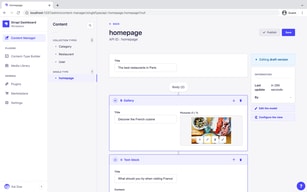
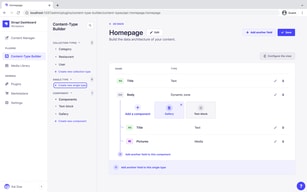
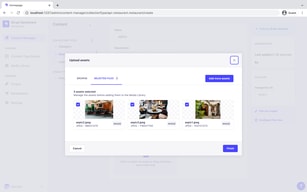
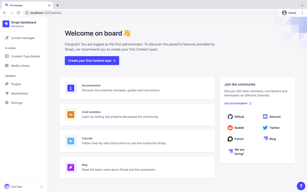
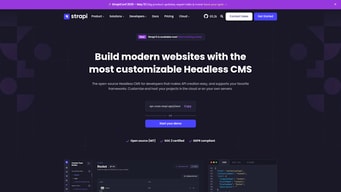
Compare Strapi with other popular tools in the same category.

How easy it is to get started. You literally have a single CLI command, go through the process of setting up the connection to the database, and you're ready to work. From there, the UI/UX is great. During the development, it's important that prototying is FAST, which it is. The customization of views and data types is just the cherry on top. Support for GraphQL comes in form of a plugin that you install with a single click. That's it. Now you have GraphQL. In a single click. The documentation is automatically generates for your API is concise and to the point.
I'm waiting for out-of-the-box TypeScript support. It's planned, so I'm not worried. Sometimes, the UI shows an error when updating the component, even though the operation was successful. You just refresh the page and it works.
When you need to tinker around with the source, the official documentation has all the information written in a legible and concise way. At our company, we have created everything from custom views, modified the branding, colors, etc. To put it in perspective: we had a detailed plan on how our API should look like, and we knew what the CMS system needs to have. From start until we were able to deploy to testing phase, it took less than an hour. We created all the custom views and branding modifications, deployed to production in a single day.
I love the customisability of Strapi. I wrote a plugin for it by following a tutorial. it was easy enough!
I would've loved to have the ability to customise the UI a bit more
It enables me to write common APIs super fast so I can spend more time on UI
Almost 0 effort to set up and get started developing, UI is extensible if you need, and lots of easy ways to deploy
It could be easier to customize the UI, you've got to do quite a bit of coding to change things
I use strapi to organize and publish articles to my blog / portfolio
Simple Model creation with rules and GraphQL API
The user access (roles, right) for admin page and API is not easy to understand. I d'ont' kown if it should be the same managment (API = Admin would be more simple)
CRUD Backend is done in 1 day max now, before STRAPI it was 20 days
Simple setup and easy creation of a Rest API, with support for graphql and easy customization of the admin dashboard.
Internationalization functions are missing although they have it with the status In Progress (Design) in the Roadmap
It solves the management of the content of a project in an easy way, with a customization of all its parts. With features like self-hosted, agnostic database, plugins to fit projects needs, open-source and free.
1. Automatic GraphQL schema generation based on models created by the content-types builder 2. Lifecycle hooks
I cannot complain about Strapi because it's beyond my expectations and it's not easy to find any flaw in Strapi. However, I found Strapi doesn't support the subscription operation out of the box which is one of the key reasons I have chosen GraphQL. But I found a workaround and it works well seamlessly. So there's nothing I dislike.
I believe all of the business logic should be implemented at server side and the client application should focus UX/UI only. But it's easier said than done. When we realize that there's something wrong with our project and wish to refactor the source codes both on client- and server-side, we don't have much time left. However, with Strapi you can rewrite the APIs at anytime in a couple of days. That's actually what happened in my company. We've decided to re-do our work that had taken a year so far because we were assured that it would be much faster to deliver our product rather than to be stuck with spaghetti codes of previous work.
Strapi is in my opinion the best headless CMS currently because of its fast api development process and its flexibility.
At first I disliked a part of the policies when it come to customize it for custom controller's actions. I took some time to make it work how I wanted.
Strapi help me to fastly build some APIs to save time and money. It's an headless CMS but I use it for more than that, I use it for general APIs too.
Strapi came at the right time when I was looking for a way to build a custom and light-weight API driven Content Management System for my Project. I got started with few hours of watching tutorials and reading the documentation. It was a real life-saver. I've developed my CMS now and Frontend & Mobile Devs are already consuming the endpoints for production ready stage.
I could barely find a fault at the moment. What I would probably say is that switching between dev and production environments could be more seamless or maybe I just haven't gotten a hang of it.
One major cool thing about Strapi is also that its open source and self-hosted backed with growing community.
Strapi offers a rich set of features and defaults to develop first-class applications quickly. Strapi grapqhql API, components, unique types and json type fields set this product apart from its competitors.
The docker image for production overpasses 1GB
Saving development time building front-end applications
Strapi is easy to get up and running quickly, even for the most junior developer. Its total cost of ownership is down to earth, especially as nearly all SaaS alternatives are overpriced. It has a solid API and has no artificial predefined limits.
No sdks and new features develop slowly.
Needed a blazing fast content management system at a scale that WordPress chokes and SaaS Headless CMS providers demand an exuberant amount of money.





